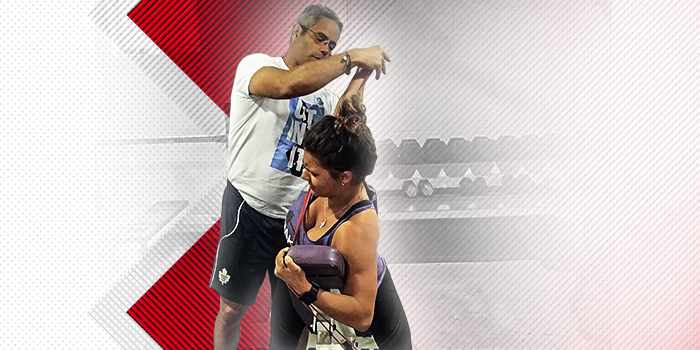
Coauthored by Scott H. Mendelson and Dr. Eric Serrano
This technique is an effective way to activate your rotator cuff, rhomboids, obliques, transverse abdominis, and lats to work synergistically with adjustable tension. Muscles never work in complete isolation, especially during competition, which makes using the specialized band rotation a great way to minimize risk of injury. Injuries often take place when the weakest link in the chain is exposed to challenges for which it is unprepared. Take, for example, an NFL player running down the field and getting blasted by a tackler who comes out of nowhere. Is it the trauma of the hard hit that caused the injury or an exposure of a weak link in the kinetic chain?
RECENT: Band Tension for the Pull-Up and Push-Up
This specialized band rotation is good for professional athletes, powerlifters, bodybuilders, weekend warriors and more! Strength athletes who are primarily training in a gym setting may become very stiff over time, pending their program designs. The big three lifts, Olympic lifts, and typical weight training movements are all very linear in nature. Competitive sports, work around the house, and manual labor are more dynamic in nature and involve needs for rotation. Trainees who get too stiff and allow for weaknesses to develop may look great but blow out their back reaching down to pick up a nickel.
Power Movements Start with the Core
Athletic movements in most cases start with the core and not the extremities. Core muscles not only need to fire quickly but also must coordinate efficiently to drive excellent rates of speed and power. The internal and external obliques that are heavily involved with functional rotation are often neglected and therefore extremely weak, which Dr. Serrano sees when he evaluates professional athletes, amateurs, executives, and more. During June and July, a number of NFL athletes visit Dr. Serrano to resolve lingering problems and prepare for the upcoming season, leading to the design of numerous unique exercises to address patient needs. The specialized band rotation was built out of necessity and has proven to be highly effective for athletes from many sports.
Resistance Adjustments
A thin resistance band can provide significant challenge, especially during the final part of the rotation. Adjust the distance at which the training partner stepping on the band is placed in reference to the bench. The farther away from the origin of the band, the greater the tension. Reaching full range of motion with proper rotation and the arch position is important. The resistance should be adjusted so the trainee can achieve the proper form.
Keep Focus on the Right Muscles
Keeping the elbow straight keeps the triceps out of the movement and places focus on the rotator cuff, rhomboids, obliques, and lats, which commonly have strategic weaknesses. Arching the back by creating distance between the chest and the bench adds more intensity to the muscle contractions during the top position of the specialized band rotation. A two-second hold in the top position will feel like an eternity against the band tension and is extremely beneficial.
Complex movements should be done at the start of a training session while the muscles and nervous system are fresh. Beginning training sessions with movements designed to prevent weaknesses can also serve as an excellent warm-up for the muscles, joints, and nervous system. Dr. Serrano uses this and similar movements for rehabbing complex injuries or weaknesses. Inserting complex exercises into training programs to prevent injuries and to improve power in specific positions is extremely important for competitive athletes. Many bodybuilders lack rotator cuff and rhomboid development due to sub-optimal training program design. In many cases, trainees may attempt to address the rotator cuff and rhomboids but choose the wrong exercises to do the job. Over time it becomes more difficult for experienced trainees to engage support muscles properly. Athletes, weekend warriors, and bodybuilders typically have oblique and lower lat dysfunction, which limits their progress.
Specialized Band Rotation Progressions
Progression One: Mastering Range of Motion
Jessica Serrano uses her free hand to hold the side of the bench during the first demonstration, which adds to her stability and allows her to focus on the rotation and proper arch position. We strongly advise starting with this execution and emphasizing the proper form with gradually higher band tension for the first four weeks using the specialized band rotation.
Progression Two: Isometric Lower Lat Contractions
A second partner will hold one end of the band while the other is in the free hand of the person doing the exercise. Dr. Serrano developed this advanced progression to simultaneously recruit oblique and the lower portion of latissimus dorsi on both sides of the body. Keeping consistent tension with the free hand and placing the elbow near the bottom of the lat are both very important. The action of the free arm creates an isometric contraction of the lower portion of the lat. Progression two is extremely difficult to execute, as multiple stimuli are in play at the same time. Keep the trap down by moving the trapezius closer to the waistline, which allows for proper muscle engagement.
Progression Three: Increased Band Tension and Point of Origin Adjustments
During the final video, Dr. Serrano performs the most challenging version of the specialized band rotation. Scott Mendelson holds the band for Dr. Serrano’s free hand at an angle on the opposite side of the bench, which intensifies the band tension significantly. Reaching full range of motion in the top position and maintaining the isometric contraction of the lower lat becomes extremely difficult with this band position.
Intelligent Partner Resistance
Torturing training partners is a right of passage for many groups, but not appropriate in this situation. The resistance of the bands must be used intelligently throughout each set. Partners can adjust the tension accordingly to support the full range of motion. For example, during a four-repetition set the fatigue may be tremendous by the end of repetition two. In this case, moving the band origin closer to the bench will help to accommodate the fatigue curve and allow the trainee to gain a full range of motion. A skilled strength coach can adjust the band position over the course of time for each individual athlete while monitoring their recovery capabilities very closely.
Athletic Position
Get into an athletic position on the bench with the knees flexed to help the hips engage properly. The length of the bench and height of the athlete will dictate the position of the hips, knee flexion, and foot placement. Start an upper body training session with this routine one time per week. Complete the specialized band rotation for three sets of four reps with a 3-1-1-2 speed. Be sure to rest 60 seconds between each set. Each set includes performing the exercise for both arms. In other words, perform four reps for each side per set. Take three seconds to come down from the top position under control, pause for one second on the bottom, take one second to reach the top position with full rotation, and pause for two seconds against resistance in the top position.
Scott H. Mendelson, director of www.InfinityFitness.com, is a highly regarded performance nutrition and training specialist. In addition to designing customized programs for his celebrity, weekend warrior and executive clients, Scott works daily with professional athletes from the NFL, NHL, MLB, NBA and NCAA. Scott has built an excellent reputation providing effective supplements, cutting-edge information, and unmatched service to thousands of clients worldwide since 1999.
Scott@infinityfitness.com Special assistant to Dr. Eric Serrano MD, Scott helps with the design of training, nutrition and supplementation trials to confirm the effectiveness of protocols and expand his expertise.
Dr. Eric Serrano, MD, is the ace sought out by elite athletes and business professionals around the world for help with the most difficult of problems. Dr. Serrano spends a majority of his time promoting the success of his family practice patients in Pickerington; a suburb of Columbus Ohio. Amongst the thousands of patients are elite athletes from around the globe who will travel to the ends of the earth to consult with Dr. Serrano.









